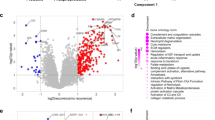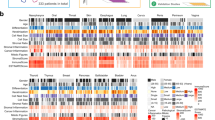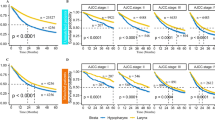Abstract
Development of head and neck squamous cell carcinoma (HNSCC) is a multistep process and in many cases involves a phenomenon coined ‘field cancerization’. In order to identify changes in protein expression occurring at different stages of tumorigenesis and field cancerization, we analysed 113 HNSCCs and 73 healthy, 99 tumor-distant and 18 tumor-adjacent squamous mucosae by SELDI-TOF-MS on IMAC30 ProteinChip Arrays. Forty-eight protein peaks were differentially expressed between healthy mucosa and HNSCC. Calgizarrin (S100A11), the Cystein proteinase inhibitor Cystatin A, Acyl-CoA-binding protein, Stratifin (14-3-3 sigma), Histone H4, α- and β-Hemoglobin, a C-terminal fragment of β-hemoglobin and the α-defensins 1–3 were identified by mass spectrometry. The α-defensins showed various alterations in expression as validated by immunohistochemistry (IHC). Supervised prediction analysis revealed excellent classification of healthy mucosa (94.5% correctly classified) and tumor samples (92.9% correctly classified). Application of this classifier to the tumor-adjacent and tumor-distant mucosa samples disclosed dramatic changes: only 59.6% of the tumor-distant biopsies were classified as normal, 27.3% were predicted as aberrant or HNSCC. Strikingly, 72% of the tumor-adjacent mucosae were predicted as aberrant. These data provide evidence for the existence of genetically altered fields with inconspicuous histology. Comparison of the protein profiles in the tumor-distant-samples with clinical outcome of 32 patients revealed a significant association between aberrant profiles with tumor relapse events (P=0.018; Fisher's exact test, two-tailed). We conclude that proteomic profiling in conjunction with protein identification greatly outperforms histopathological diagnosis and may have significant predictive power for clinical outcome and personalized risk assessment.
This is a preview of subscription content, access via your institution
Access options
Subscribe to this journal
Receive 50 print issues and online access
$259.00 per year
only $5.18 per issue
Buy this article
- Purchase on Springer Link
- Instant access to full article PDF
Prices may be subject to local taxes which are calculated during checkout





Similar content being viewed by others

References
Abrahamson M, Alvarez-Fernandez M, Nathanson CM . (2003). Biochem Soc Symp 70: 179–199.
Ai H, Barrera JE, Meyers AD, Shroyer KR, Varella-Garcia M . (2001). Laryngoscope 111: 1853–1858.
Ai H, Barrera JE, Pan Z, Meyers AD, Varella-Garcia M . (1999). Mutat Res 439: 223–232.
Albrethsen J, Bogebo R, Gammeltoft S, Olsen J, Winther B, Raskov H . (2005). BMC Cancer 5: 8.
Alho H, Kolmer M, Harjuntausta T, Helen P . (1995). Cell Growth Differ 6: 309–314.
Andl T, Kahn T, Pfuhl A, Nicola T, Erber R, Conradt C et al. (1998). Cancer Res 58: 5–13.
Bedi GC, Westra WH, Gabrielson E, Koch W, Sidransky D . (1996). Cancer Res 56: 2484–2487.
Braakhuis BJ, Leemans CR, Brakenhoff RH . (2005). Semin Cancer Biol 15: 113–120.
Braakhuis BJ, Tabor MP, Kummer JA, Leemans CR, Brakenhoff RH . (2003). Cancer Res 63: 1727–1730.
Braakhuis BJ, Tabor MP, Leemans CR, van der Waal I, Snow GB, Brakenhoff RH . (2002). Head Neck 24: 198–206.
Buhimschi IA, Christner R, Buhimschi CS . (2005). Bjog 112: 173–181.
Califano J, van der Riet P, Westra W, Nawroz H, Clayman G, Piantadosi S et al. (1996). Cancer Res 56: 2488–2492.
Carr S, Aebersold R, Baldwin M, Burlingame A, Clauser K, Nesvizhskii A . (2004). Mol Cell Proteomics 3: 531–533.
Chavakis T, Cines DB, Rhee JS, Liang OD, Schubert U, Hammes HP et al. (2004). FASEB J 18: 1306–1308.
Dellambra E, Golisano O, Bondanza S, Siviero E, Lacal P, Molinari M et al. (2000). J Cell Biol 149: 1117–1130.
Freier K, Joos S, Flechtenmacher C, Devens F, Benner A, Bosch FX et al. (2003). Cancer Res 63: 1179–1182.
Ganz T . (2003). Nat Rev Immunol 3: 710–720.
Garcia SB, Park HS, Novelli M, Wright NA . (1999). J Pathol 187: 61–81.
Gasco M, Bell AK, Heath V, Sullivan A, Smith P, Hiller L et al. (2002). Cancer Res 62: 2072–2076.
Hegedus CM, Gunn L, Skibola CF, Zhang L, Shiao R, Fu S et al. (2005). Leukemia 19: 1713–1718.
Hermeking H, Lengauer C, Polyak K, He TC, Zhang L, Thiagalingam S et al. (1997). Mol Cell 1: 3–11.
Homann N, Nees M, Conradt C, Dietz A, Weidauer H, Maier H et al. (2001). Clin Cancer Res 7: 290–296.
Kerkhoff C, Klempt M, Sorg C . (1998). Biochim Biophys Acta 1448: 200–211.
Le Bihan MC, Tarelli E, Coulton GR . (2004). Proteomics 4: 2739–2753.
Lundy FT, Orr DF, Gallagher JR, Maxwell P, Shaw C, Napier SS et al. (2004). Oral Oncol 40: 139–144.
Melle C, Ernst G, Schimmel B, Bleul A, Koscielny S, Wiesner A et al. (2004). Cancer Res 64: 4099–4104.
Muller CA, Markovic-Lipkovski J, Klatt T, Gamper J, Schwarz G, Beck H et al. (2002). Am J Pathol 160: 1311–1324.
Nees M, Homann N, Discher H, Andl T, Enders C, Herold-Mende C et al. (1993). Cancer Res 53: 4189–4196.
Partridge M, Pateromichelakis S, Phillips E, Emilion GG, A'Hern RP, Langdon JD . (2000). Cancer Res 60: 3893–3898.
Petrescu AD, Payne HR, Boedecker A, Chao H, Hertz R, Bar-Tana J et al. (2003). J Biol Chem 278: 51813–51824.
Prevo LJ, Sanchez CA, Galipeau PC, Reid BJ . (1999). Cancer Res 59: 4784–4787.
Roesch Ely M, Nees M, Karsai S, Magele I, Bogumil R, Vorderwulbecke S et al. (2005). Eur J Cell Biol 84: 431–444.
Shiraishi T, Mori M, Tanaka S, Sugimachi K, Akiyoshi T . (1998). Int J Cancer 79: 175–178.
Simon R, Radmacher MD, Dobbin K, McShane LM . (2003). J Natl Cancer Inst 95: 14–18.
Sinha AA, Quast BJ, Wilson MJ, Fernandes ET, Reddy PK, Ewing SL et al. (2002). Cancer 94: 3141–3149.
Slaughter DP, Southwick HW, Smejkal W . (1953). Cancer 6: 963–968.
Smith-McCune K . (1997). Obstet Gynecol 89: 482–483.
Soder AI, Hopman AH, Ramaekers FC, Conradt C, Bosch FX . (1995). Cancer Res 55: 5030–5037.
Tabor MP, Brakenhoff RH, Ruijter-Schippers HJ, Kummer JA, Leemans CR, Braakhuis BJ . (2004). Clin Cancer Res 10: 3607–3613.
Tabor MP, Brakenhoff RH, van Houten VM, Kummer JA, Snel MH, Snijders PJ et al. (2001). Clin Cancer Res 7: 1523–1532.
Tolson JP, Flad T, Gnau V, Dihazi H, Hennenlotter J, Beck A et al. (2006). Proteomics 6: 697–708.
Vlahou A, Schellhammer PF, Mendrinos S, Patel K, Kondylis FI, Gong L et al. (2001). Am J Pathol 158: 1491–1502.
Waridel F, Estreicher A, Bron L, Flaman JM, Fontolliet C, Monnier P et al. (1997). Oncogene 14: 163–169.
Wiesner A . (2004). Curr Pharm Biotechnol 5: 45–67.
Wilkins MR, Appel RD, Van Eyk JE, Chung MC, Gorg A, Hecker M et al. (2006). Proteomics 6: 4–8.
Wolf C, Flechtenmacher C, Dietz A, Weidauer H, Abel U, Maier H et al. (2004). Laryngoscope 114: 698–704.
Wright Jr GL . (2002). Expert Rev Mol Diagn 2: 549–563.
Acknowledgements
Grant support: We specially thank the CAPES (Coordenação de Aperfeiçoamento de Pessoal de Nível Superior) for financial support to M Roesch-Ely. We greatly appreciate the help from our medical staff in collecting and processing the tissue specimens, and Dr Christa Flechtenmacher, Pathologisches Institut der Universität Heidelberg, for histopathological assessment and fruitful discusssions. We thank Antje Schuhmann and Nataly Henfling for excellent technical support. Equipment was financed via the ‘Hochschulbau-Förderungsgesetz’. This study was in part supported by the ‘Forschungsförderungsprogramm der Medizinischen Fakultät Heidelberg’, Grant No. 007 and a grant from the National Genome Research Network to MS (Förderkennzeichen 01GS0460).
Author information
Authors and Affiliations
Corresponding author
Additional information
Supplementary Information accompanies the paper on the Oncogene website (http://www.nature.com/onc).
Rights and permissions
About this article
Cite this article
Roesch-Ely, M., Nees, M., Karsai, S. et al. Proteomic analysis reveals successive aberrations in protein expression from healthy mucosa to invasive head and neck cancer. Oncogene 26, 54–64 (2007). https://doi.org/10.1038/sj.onc.1209770
Received:
Revised:
Accepted:
Published:
Issue Date:
DOI: https://doi.org/10.1038/sj.onc.1209770
Keywords
This article is cited by
-
Treating Head and Neck Cancer in the Age of Immunotherapy: A 2023 Update
Drugs (2023)
-
Specific Smad2/3 Linker Phosphorylation Indicates Esophageal Non-neoplastic and Neoplastic Stem-Like Cells and Neoplastic Development
Digestive Diseases and Sciences (2021)
-
Telomeres and telomerase in head and neck squamous cell carcinoma: from pathogenesis to clinical implications
Cancer and Metastasis Reviews (2016)
-
The molecular biology of head and neck cancer
Nature Reviews Cancer (2011)
-
Translationale Forschung bei Kopf-Hals-Tumoren
HNO (2011)


